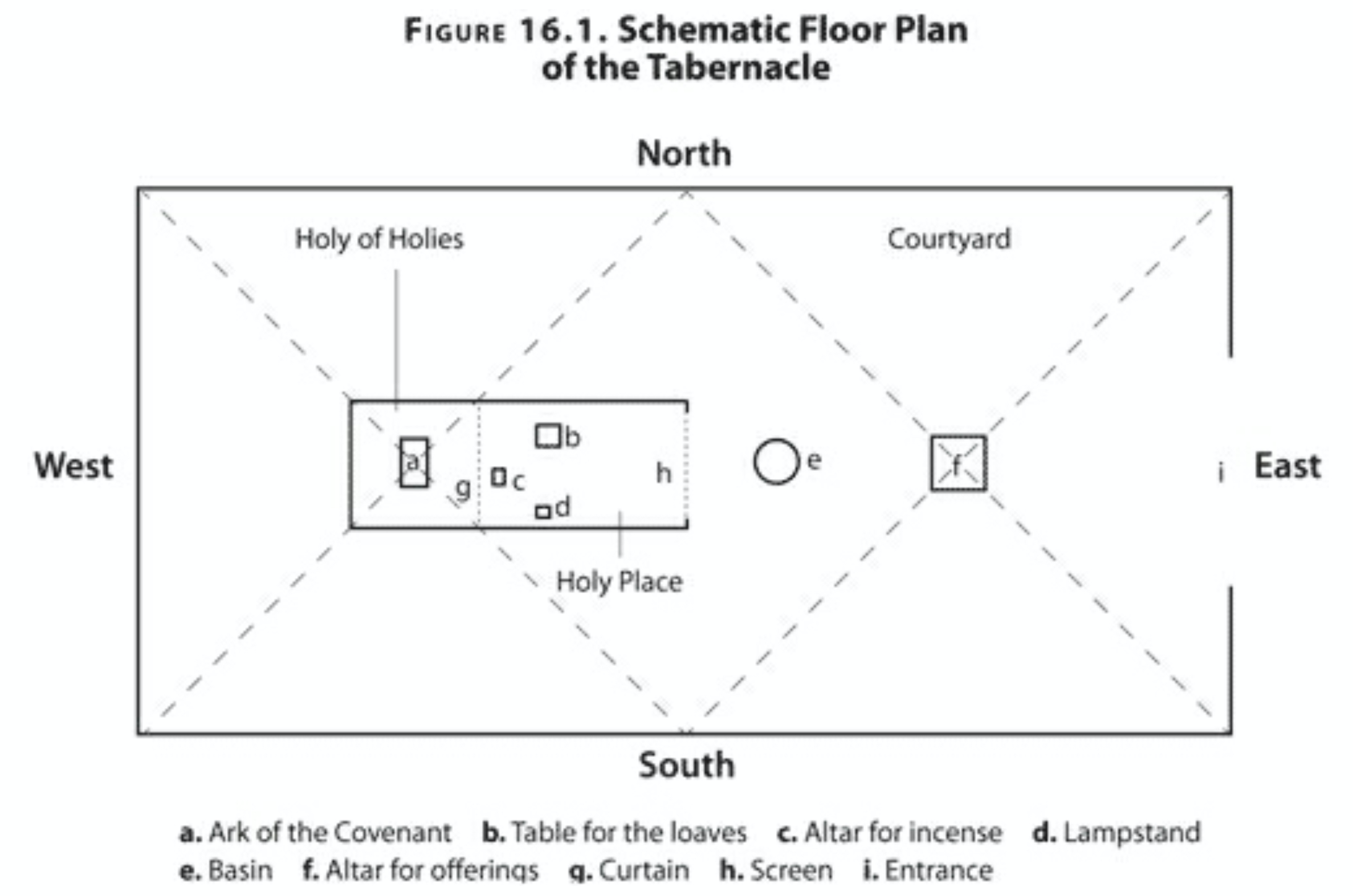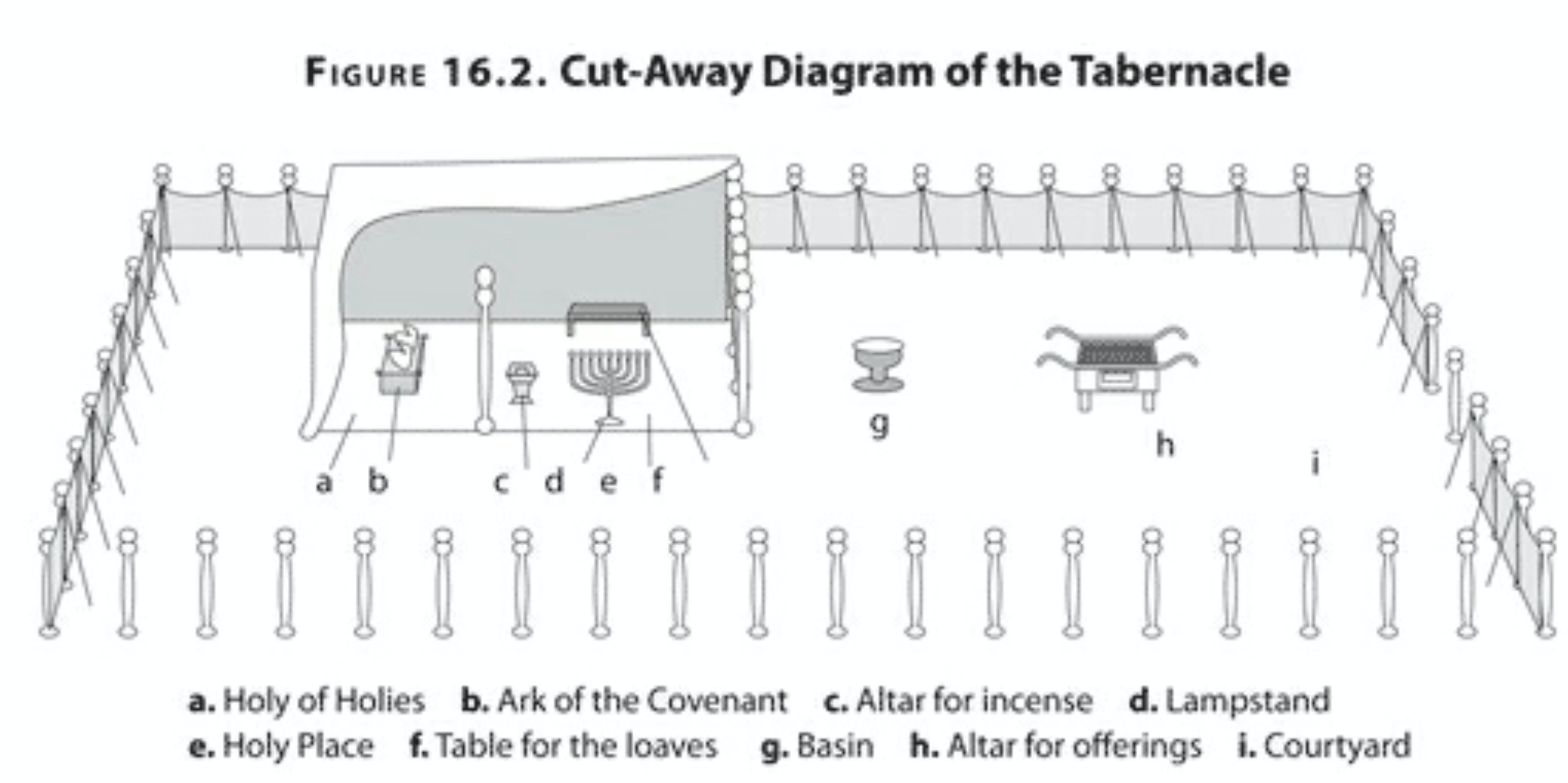The Tabernacle
A rectangular tent - meeting space between God and people;
Extensive use of gold and blue fabrics - a royal residence,
Portable - to make sure that the divine king will be with his people wherever they go.
The outer curtain fence separates sinful people from a holy God;
The bronze altar reminds that only after the atonement for sins God can be approached.
Introduction
Ex 25:1-31:11 - the description of how the tent and its furnishing should be manufactured;
Ex 35:1-40:33 - the construction.
Thus, one-quarter of Exodus describes the making of the tabernacle.
The list above shows the importance of the objects;
In this order, the items are assembled;
Everything is made just as Moses has been instructed.
Ex 40:17 - ends with God’s glory fills the tabernacle “on the first day of the first month in the second year”;
Just in time for the people to celebrate the first anniversary of their deliverance from Egypt (Num 9:1-5).
A royal tent
The Lord intents to dwell among the people (Ex 25:8; 29:45-46);
And since people live in the tents, so the Lord.
But, it is not a common tent (Ex 25:3-7; 35:5-9, 22-27 - look at the material) - it is for royal use.
Ex 38:21-31 - Approximately
one ton of gold,
four tons of silver,
and two-and-a-half tons of bronze
Are used to make the tabernacle and its furnishings.
Today, around 7,777,787 USD
Three items for the inside of the tent
1. the Ark - Ex 25:10-22
Rectangular wooden chest with gold rings and poles (Ex 25:10-11; 12-15).
The lid of the ark, made of pure golf, is designated as “atonement cover” (Ex 25:17; Hebr 9:5)
Leviticus 16:1-34 (esp. vv. 11-17) describes the annual ritual, which takes place when the high priest sprinkles blood on the ark’s lid to make atonement for “the uncleanness and rebellion of the Israelites, whatever their sins have been” (Lev 16:16).
Two golden cherubim are attached to the ends of the lid, facing each other with outspread wings.
Cherubim were the traditional guardians of holy places in the ancient Near East.
Others cherubim were woven into the curtains that surrounded the tabernacle and those that separate the Holy of Holies from the Holy Place (Ex 26:1,31).
It indicates that the way into the immediate presence of God is barred to sinful humans (Gen 3:24)
Between the cherubim, God would meet with Moses (Ex 25:22; 30:36; Lev 16:2).
The ark is not only a container for the Ten Commandments, the Manna, and the stick of Aaron.
The Ark also functions as the footstool of a throne.
2. Wooden table (Ex 25:23-30).
Plates, dishes, and other utensils, all of gold, are to be provided, and the “bread of the Presence” is to be placed on the table “at all times” (Ex 25:29-30).
3. Menorah - Gold lamp-stand with seven lamps (Ex 25:31-39).
It is made in the pattern of a growing tree,
Decorated (see Ex 25:31)
Was it aim to resemble the tree of life (Gen 3:22)?
Interesting
The table, a lamp stand, and the wooden box/footstool, comprised the main items of furniture in an ancient home.
Thus, the tent was God’s home.
The gold emphasises the importance of the occupant.
The provision of bread (Ex 25:30) and light (Ex 27:21) symbolise that God is there day and night.
The Tent (Tabernacle)
(Ex 26:1-37)
The rectangular structure is divided into two rooms by a curtain - one room probably twice the size of the other (Ex 26:31-33).
The ark is in the smaller room - western half of the tabernacle - the Holy of Holies (Ex 26:34).
In the bigger room - Holy Place - was placed the golden table and lamp stand (Ex 26:35)
4. An incense altar with four horns (Ex 30:1-10) - made of acacia wood and plated with pure gold.
It was also placed in the Holy Place.
Twice a day Aaron is to burn fragrant incense upon it;
{Once a year, probably on the Day of Atonement (Lev 16:15-19), Aaron is to make atonement on its horns (Ex 30:10)}
A Holy Tent
Around the tabernacle, Moses is to construct a courtyard by erecting a curtain fence.
A rectangle of 50 meters by 25 meters and two-and-a-half meters high.
The only entrance is on the eastern side.
Upon entering there is a large bronze altar before approaching the tabernacle.
The fence and the curtain separates the rest of Israelite encampment from this holy area (Ex 19:12-13,21-24). It is also a protection, so the people will not approach God inadvertently (by accident).
Only the tabernacle is more sacred.
Here, the materials used are silver and bronze.
The priests
The area is a holy ground so the priests needs also to be holy.
The ‘sacred garments’ indicate their holiness.
Ex 28:5 - gold, blue, purple, scarlet yarn, fine linen.
Ex 28:4 - Aaron;
Ex 28:40 - Aaron sons
Ephod
(Ex 28:6-14)
Not possible to reconstruct it exactly, but
Two precious stones engraved with the names of the twelve tribes of Israel (Ex 28:11-12).
They remind that Aaron serves as high priests on behalf od all the Israelites.
Breast-piece
(Ex 28:15-30)
A square pouch that the high priest wears over his chest.
Four rows of precious stones - three stone in each row;
Each stone is inscribed with the name of an Israelite tribe.
The same symbolism like with the ephod. Aaron serves on behalf of the people.
“The Urim and the Thummim” inside the pouch (Ex 28:30).
Difficult to assess how it looked.
The purpose (Ex 22:8,9 - probably such cases were decided by the use of “Urim and Thummim”; Num 27:21).
Other items of clothing
Ex 28:31-43
A blue robe with golden bells - (announcing to God that he is coming into His presence?)
Turban with a golden plate and the words “Holy to the Lord (Ex 28:36).
Tunic and sash (Ex 28:39)
Underwear (Ex 20:26; cf Gen 3:7; 10:21).
Preparation for the service
(Ex 29:1-46)
1. Moses needs to wash and clothe Aaron and his sons in their priestly garments (29:4-9).
And anoint them with oil (Ex 30:22-30;31-33)
2. Three sacrifices - a bull and two rams.
A bull for purification (Ex 29:10-14);
The first ram (Ex 29:15-18) - a whole-burnt offering.
It atones for the sins of Aaron and his sons (cf Lev 1:10-13).
The Second ram (Ex 29:19-34) - peace offering (cf Lev 3:6-11).
The ritual
1. Aaron, his sons, and their garments are to be purified by sacrificial blood (Ex 29:19-21);
2. Ex 29:22-35 - the remuneration that Aaron and his sons are to receive as priests;
The breast given to all the priests;
A thigh given to the priest who officiates (Lev 7:28-36).
By eating the sacrificial meat, the priests are sanctified - made holy.
(One can think about participating in the Eucharist)
The ritual is essential for the consecration of the priests.
A bronze basin
(Ex 30:17-21)
It was placed between the tabernacle and the bronze altar so the priests could wash their hands and feet when serving within the tabernacle and courtyard (Ex 30:17-21).
The purpose for washing to remain holy and pure (cf. Ex 19:14; 29:4).
A Tent of Meeting
(Ex 29:43)
The tabernacle:
1. A royal “residence”;
2. A holy space;
3. A meeting place.
Like the Garden of Eden, the tabernacle is the place where divinity and humanity commune together.
But, since humanity is already affected by sin (unlike in Eden), so to meet a holy God, the people need to be sanctified from their sin and uncleanness.
And so, a portable bronze-plated altar, placed in the courtyard, is needed (Ex 27:1-8).
It is 2.5 meters wide and 1.5 meters high.
The altar is placed between the courtyard and the tabernacle.
A worshipper can approach God only after offering a sacrifice to atone for sin.
The tent of meeting seemed to replace the previous tent of meeting (Ex 33:7-11) placed outside the main camp.
The Lord dwells in the newly constructed tent (Ex 40:35) and from there he guides Israel on their journeys (Ex 40:36-38).
But, it was not God’s main residence (Ex 26:30).
Read Deut 26:15.
The provision of Materials and skilled Craftsmen
Materials
Free donations from the people (Ex 25:1-7);
Ex 35:4-9; 20-27 - the people responded generously.
They even had to be restrained from giving too much (Ex 36:3-7).
Craftsmen
Ex 31:1-11
Bezalel and Oholiab - filled with “the Spirit of God” (Ex 31:3). They also teach others (Ex 35:34).
The women were spinning yarn for the curtains (Ex 35:25-26).
Bezalel’s discerning artistry in tabernacle-building images God’s own construction of the cosmos (Ex 31:3; Prov 3:19-20; Gen 2:2-3; Gen 1:2).
Connect the words: wisdom, understanding, knowledge, and ‘all crafts’ or ‘all works’, and ‘the Spirit of God’.
Notice also that Bezalel was from the tribe of Judah (Ex 35:30). And his name means “in the shadow [protection] of God”.
Thus, the tabernacle replicate in microcosm the macrocosmic sanctuary of the entire created order.
The tabernacle is viewed as a model of the world.
It anticipates a time when the whole world will be filled with God’s glorious presence.
The tabernacle was replaced by a temple modelled on it and constructed first by Solomon and later rebuilt at the end of the sixth century BC.
New Testament Connections
Jesus and the tabernacle/temple
John 1:14 - (pitched a tent) among us.
John 2:19 - Jesus’ body as the temple.
Transition
God moves from dwelling within Jerusalem temple to living within the post-Pentecost followers of Jesus.
Eph 2:19-22 - “A holy temple in the Lord”;
See also 1 Cor 3:16-17; 6:19; see also 2 Cor 6:16.
God’s glory in the lives of Christian
(2 Cor 3:18)
The Church is the new temple of God.
And Paul is a “skilled master builder” (1 Cor 3:10) like Bezalel.
Samaritan woman
(John 4:21-24)
Worship of God is not restricted to any particular location.
Jerusalem temple - just a copy of the real one
Hebr 8:5; 9:11,24
The real one is in heaven.
The earthly temple, like the time of Moses’ law, was limited, and so it will be ‘shut down’ (Mk 13:1-2).
1. When Jesus died, the curtain in the temple, separating the ‘Holy of Holies’ from the ‘Holy Place’ was torn from top to bottom (Mt 27:51).
Thus, the barrier separating God and humanity was removed (Heb 9:1-8).
2. Jesus enters the heavenly sanctuary to serve as a high priest (Heb 9:24; cf. Heb 9:11-28).
Fulfilment
Rev 21-22 - the new Jerusalem coming down from heaven.
A gigantic golden cube without any temple (cf 1 Kings 6:20). A new “Holy of Holies”?
2,200 kilometers, in length, width, and height (Revelation 21:15-16).
A metropolis of this size in the middle of the United States would stretch from Canada to Mexico and from the Appalachian Mountains to the California border.
Why no temple?
“Because the Lord God Almighty and the Lamb are its temple” (Rev 21:22).
Previous
Next



